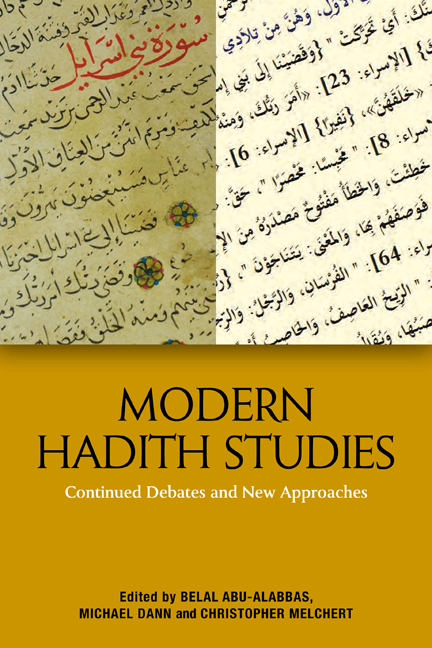Book contents
- Frontmatter
- Contents
- Figures and Tables
- Acknowledgements
- Note on Conventions
- Notes on Contributors
- Introduction
- 1 Kunnā nakrahu al-kitāb: Scripture, Transmission of Knowledge, and Politics in the Second Century AH (719–816 ce)
- 2 The History of the Adhān: a View from the Hadith Literature
- 3 Ibn al-Mubārak, Traditionist
- 4 Early ‘Traditionist Sufis’: A Network Analysis
- 5 The Common Link and its Relation to Hadith Terminology
- 6 Hadith Criticism between Traditionists and Jurisprudents
- 7 Hadith Criticism in the Levant in the Twentieth Century: From ẓāhir al-isnād to ʿilal al-ḥadīth
- 8 The Reception and Representation of Western Hadith Studies in Turkish Academe
- 9 Can Different Questions Yield the Same Answers? Islamic and Western Scholarship on Shiʿi Narrators in the Sunni Tradition
- Index
2 - The History of the Adhān: a View from the Hadith Literature
Published online by Cambridge University Press: 01 October 2020
- Frontmatter
- Contents
- Figures and Tables
- Acknowledgements
- Note on Conventions
- Notes on Contributors
- Introduction
- 1 Kunnā nakrahu al-kitāb: Scripture, Transmission of Knowledge, and Politics in the Second Century AH (719–816 ce)
- 2 The History of the Adhān: a View from the Hadith Literature
- 3 Ibn al-Mubārak, Traditionist
- 4 Early ‘Traditionist Sufis’: A Network Analysis
- 5 The Common Link and its Relation to Hadith Terminology
- 6 Hadith Criticism between Traditionists and Jurisprudents
- 7 Hadith Criticism in the Levant in the Twentieth Century: From ẓāhir al-isnād to ʿilal al-ḥadīth
- 8 The Reception and Representation of Western Hadith Studies in Turkish Academe
- 9 Can Different Questions Yield the Same Answers? Islamic and Western Scholarship on Shiʿi Narrators in the Sunni Tradition
- Index
Summary
In most hadith collections, there are narratives concerned with the so-called beginning of the adhān, badʾ al-adhān or badʾ al-nidāʾ. They recount the introduction of the Islamic call to prayer and explain how Muslims, inspired by Jewish and Christian practices, developed their own ritual. The history of the adhān and its introduction raises numerous questions. Why and how was the Islamic call to prayer introduced? What role did Jewish and Christian rituals play? Was there a development phase or was it always the same set of chanted formulae? Who were the people interested in the history of its introduction and why did they narrate it?
Using close textual analysis and recent methodological development in hadith studies, I have reconstructed a potential common structure underlying all the texts, which I have called the ‘proto-narrative’. The results of my research show that the narrators and transmitters used this proto-narrative to construct different narratives, variously intertwining historical facts with oneiric traditions, disguised political statements or religious claims. Often, we can identify the characteristics of transmission processes by certain narrators or collectors. Systematic analysis of the primary sources was performed with the help of network visualisation tools to produce data-dense graphs of transmission, unfolding in time and space. The results of the present research contribute to a better understanding of the birth of the Islamic call to prayer at the time of the Prophet and its cultural implications for the following decades. They also shed light on the mechanisms employed in some of the narratives to promote different viewpoints.
General Outline
When the narratives concerned with the introduction of the adhān are put together, it appears clearly that they all follow the same storyline despite their numerous differences: at some point Muslims felt the need to develop their call to prayer. They thought about, or used, the Jewish trumpet or the Christian semantron, before someone suggested a call to prayer consisting of chanted formulae. The accounts narrating the introduction of the adhān can be divided into three different categories in terms of content (matn) and chain of transmitters (isnād). The first category contains narratives attributed to Ibn ʿUmar that are present in almost all the main hadith collections.
- Type
- Chapter
- Information
- Modern Hadith StudiesContinuing Debates and New Approaches, pp. 27 - 48Publisher: Edinburgh University PressPrint publication year: 2020



